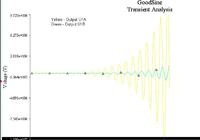Audioguru
Advanced Member level 7
- Joined
- Jan 19, 2008
- Messages
- 9,455
- Helped
- 2,151
- Reputation
- 4,302
- Reaction score
- 2,008
- Trophy points
- 1,393
- Location
- Toronto area of Canada
- Activity points
- 59,700
The lousy old LM324 and LM358 opamps were the first low power opamps. Their design saves power by operating the output transistors with no quiescent current (class-B) which causes crossover distortion.
Ordinary opamps use class-AB for the output transistors. Class-AB produces a small quiescent current in the output transistors to eliminate crossover distortion.
You cannot get inside the circuit of the LM324 or LM358 opamps to add quiescent current for class-AB but you can add a pull-up or pull-down resistor to their output to operate one of the output transistors in class-A for no crossover distortion if the current is high enough.
But the LM324 and LM358 also save power by having a very poor high frequency response. They have trouble above only 2kHz. Most opamps work fine up to 100kHz (except a 741 opamp has trouble abover only 9kHz).
Ordinary opamps use class-AB for the output transistors. Class-AB produces a small quiescent current in the output transistors to eliminate crossover distortion.
You cannot get inside the circuit of the LM324 or LM358 opamps to add quiescent current for class-AB but you can add a pull-up or pull-down resistor to their output to operate one of the output transistors in class-A for no crossover distortion if the current is high enough.
But the LM324 and LM358 also save power by having a very poor high frequency response. They have trouble above only 2kHz. Most opamps work fine up to 100kHz (except a 741 opamp has trouble abover only 9kHz).
